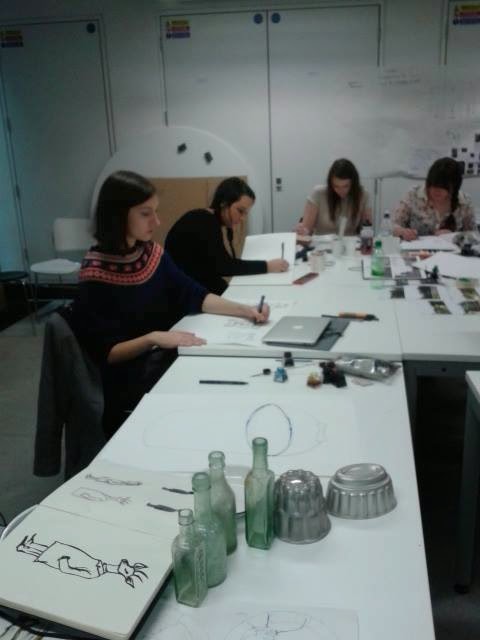In the past I have generally stuck to drawing and painting
as a starting point for motif making, as I know it is a system that works well
for me; but I have found it very beneficial taking a different approach and
being more experimental early on in the project as I have created some striking
imagery to work into my prints. I have learnt that it is also good to vary my
content, and I think that more bold and graphic motifs contrasted with my usual
softer line drawings will create some interesting prints. I really enjoyed
using collage in my last project, so it has been good to further push my skills
with this technique. Doing the Patternmash brief has also really helped my
work, as I started to think about the layout of prints much earlier than I
usually would in a project; in the future it may help to start playing around
with print layouts at the same time as drawing motifs so that I can create
drawings for a particular purpose, rather than my usual pattern of drawing then
print making.
Even though I did not collaborate with anyone to create my
final product, the collaborative side of the project has had a big impact on my
work. The fact that there were very few other print students who picked this
option meant that I’ve pushed myself to interact with students from other
areas. I have found it really beneficial seeking advice and opinions from the
weave students as they have a very different approach to textiles (for
instance, I would usually have not have considered making my own tassels for my
scarves before they suggested it), and I feel I can offer them more design
based advice, such as helping Eden with her Photoshop skills. On plenty of
occasions I have met up with illustration student Julia to talk through our
ideas, which has been so useful to get her opinion on my work as I have a very
illustrative style, and she has made me realise that there are many options out
there other than just fabric-based outcomes. This is also the case with talking
to the 3D design students; it has been so interesting seeing their take on the
project, and even though I haven’t ended up collaborating with a ceramics
student, I felt that the collaborative drawing workshop we did really helped to
kick start ideas in my project. I definitely think that I would like to collaborate
with students from other disciplines again as it has made me look at my own
practice with fresh eyes.
I have played around with materials and drawing styles in
this project, using papercuts to create lace-like patterns that could be turned
into brushes on Photoshop. After playing around with different techniques I
decided I wanted to reflect this strong graphic feel in my drawings, so I used
pen and gouache to make drawings that looked like they could be paper cuts.
Although they would translate very well as screen prints, I want to use
Photoshop for its ability to really layer up stencil images with drawings,
textures and photographs.
I loved the idea of collaborating on a ceramic piece
with one of the 3D design students, but discussions with tutors made me realise
that it would benefit my practice to work further with scarves, and in the time
scale of this project it made more sense to work with techniques that I already
know to create a really slick end product. I have designed square scarves in
the past but they are usually placement prints designed to focus on the corners,
whereas long scarves are worn totally differently, so I want the focus of the
print to be on the ends. I understand the importance of knowing my market
place, so I did further research to see what type of scarves the National Trust
already sell, looked at high street stores for a price range comparison, and
looked at higher end brands for pattern, scale and colour inspiration, all of
which has given me a clearer idea of what I think will sell well print-wise. As one of the key points of a prints success is the colour, I have spent tome putting together a colour palette that I think reflects the project, with a mix or muted and brighter colours.
I definitely want to digitally print some of my scarves to
show the viewer how my prints would look in a final context, so to do so in
time I have made a day-by-day plan of what needs doing so that my fabric can be
printed in time for the exhibition. This means that in the next few days I
really need to concentrate on creating prints so that I can swiftly move onto
finalising designs.









No comments:
Post a Comment